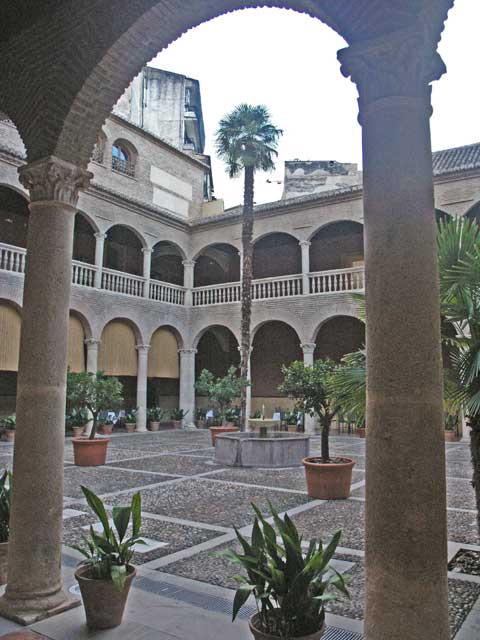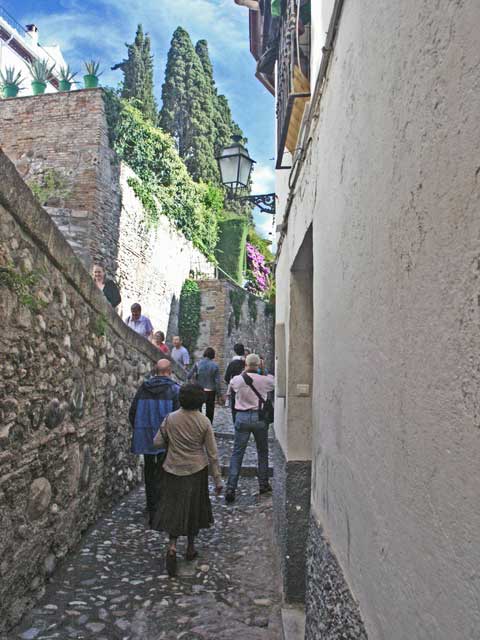
The courtyard at the AC Palacio de Santa Paula.

The plan the next morning was to get up around 0730 or so, get breakfast, and go on a city walking tour Nick had recommended. We rolled out of bed around 0830 and after shower and breakfast, made it to Plaza del Carmen with plenty of time to spare. Cicerone runs the tour and this walk was titled “From Islam to Christianity.” The tour took us back to the area around the cathedral where we had dinner last night and learned that “Bib Rambla” means “gate at the riverside” and the gate – now long gone – stood at one corner of the plaza where the restaurant is located. The guide, Rosa, led us through the narrow streets of the market that surrounds the cathedral discussing the economics and architecture of the time when Granada transitioned from Islamic to Christian rule. She described how Isabella and Ferdinand and their successor, Charles V, kept their capital in Granada, as well as accommodated their Islamic population.
We stopped outside the archbishop’s palace, which was next to the old mosque that had been converted to a church. Later, the mosque was torn down and replaced with the cathedral, which starts with a Gothic foundation, was built in Renaissance style, and finished off in Baroque. It took that long to build it. We walked around inside where the signs on the door said “No Foto” so we took none. The interior is well lit from the high windows and where the light reflected off the white marble columns and floors.
From there we crossed the main drag where our hotel was located, and entered the Albaycín, the Muslim quarter. There we stopped at another market street, the proceeded up that street to St. Gregory’s church. Rosa continued her description of how the Christian rulers of Granada (and Spain) become more and more intolerant leading first to persecution of the Muslims, then to forced conversion, then ultimately to expulsion. She also noted that this crippled the economy, as the Moors were the craftsmen, artisans, and business owners in the city. Their forced departure left a gaping hole in the fabric of the society.
We continued through the narrow streets of the Albaycín where Rosa described the architecture – the Muslim houses had no windows on the outside, instead the faced the interior courtyard. Castillean architecture had windows facing out. A third style described as “carmen” included a walled compound with gardens inside (the expulsion of the Moors included the farmers as well) where the garden could be protected from pilferage.
The next stop was by the Rio Darro at the last surviving Muslim baths in the city. Muslim tradition included ritual ablutions before attending services on Fridays. Walking along the river (again) we came to the Plaza de Santa Ana – a church built by the Muslim craftsmen using their preferred style of bricks and mortar. The tower adjacent to the church is based on the minaret of a mosque. This design served as a template for future Spanish ecclesiastical architecture it was so well received.
The tour ended in the Plaza Nueva across from the Real Chancellera built to support Granada’s function as the capital of Spain. Not long thereafter, Phillip II (Charles V’s successor) moved the capital to a village of about 150-200 people (according to Rosa) in the center of Spain, Madrid (which precipitated much hardship in Granada).
… Most cathedrals in Europe tend to have a large square in front of the building. Because the cathedral was built on the site of the local mosque and was already surrounded by buildings, only a small plaza fronts this cathedral.
… The cathedral was built after the Reconquest, so the main image of the church is the Virgin (to battle those pesky Protestants) rather than the Crucifixion (used to make the point to the Muslims and Jews).

In the Albaycín, Jonathan pauses to take a shot of the cypresses and bougainvillea at the top of the hill.
… The bell tower on this church resembles a minaret . The workers who designed and built this church were mudejar - Muslims who were forced to convert to Christianity.
After the tour at about 1300, we returned to the hotel to see if we could get reservations at Cuinini but they were booked for lunch (supper) and closed in the evening. We asked the hotel staff for a recommendation for something authentically Spanish. So she got us reservations for 2 at 1400 at “Sevilla,” located adjacent to the cathedral. So leaving the cameras in the room, we wandered on back to the area looking to spend some time before our reservation. After locating the restaurant (the “X” she made on the map made it look like it was on the cross street), we had a rather enjoyable meal – Jonathan ordered potato salad that had whitefish of some sort in it, while I ordered the warm asparagus salad with ham. Both were very delicious – the potato salad came with some wonderful green olives that were very tasty and not salty. We shared a paella as the main that had chicken, mussels, clams, and other seafood. I gave Jonathan all the mussels.
From there we returned to the hotel, set-up a wake up call (we are to meet the Country Walkers tour in the lobby at 0830) for 0600 to get to breakfast at 0700. Then we took a nap – food coma.
I’m at the bar, or what passes for it, at our hotel, Hotel Villa Turistica de Bubión, with glass of red wine (tinto) to catch up on the day’s events.
